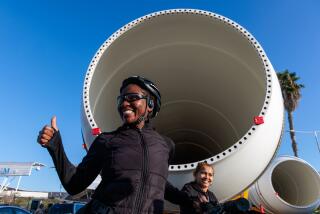Lockheed Wins Contract to Develop Next Space Shuttle
- Share via
Choosing a wing-shaped spacecraft whose design was first sketched on a note pad only four years ago, NASA awarded a $1-billion contract Tuesday to Lockheed Martin Corp. to develop the prototype for the nation’s next-generation space shuttle.
Vice President Al Gore made the announcement to a cheering, sun-baked crowd at NASA’s Jet Propulsion Laboratory in Pasadena, saying the selection of Lockheed Martin’s craft “marks the next chapter in America’s ride to new worlds” and will bolster the waning U.S. presence in the worldwide commercial launch industry.
The pact also is a big boost to Southern California’s troubled aerospace industry, because Lockheed Martin will continue development of the low-cost, reusable orbiter at the company’s famed “Skunk Works” aerospace design center in Palmdale.
Indeed, Gore confirmed that the three-year contract would generate about 2,000 new jobs in California overall, and perhaps thousands more if the rocket--known as the X-33--ever reaches mass production.
The victory was Lockheed Martin’s “fondest wish come true,” Skunk Works President Jack Gordon told a news conference at the wind-swept Palmdale plant. Gordon said the spacecraft would have the reliability of a commercial airliner: “If there’s no red lights flashing, you just put fuel in it and it goes back up again.”
But the contest ended in bitter defeat for the two other X-33 finalists, Rockwell International Corp. and McDonnell Douglas Corp., whose space operations also are based in Southern California.
The loss was especially stinging because the two companies are longtime providers of launch systems for the National Aeronautics and Space Administration. Rockwell, for instance, built the existing shuttle fleet.
McDonnell Douglas dropped plans for a victory press conference and employee party when Gore made the announcement. “We were surprised and disappointed,” said McDonnell Douglas spokeswoman Anne Toulouse in Huntington Beach. “We felt we had a winning proposal.”
At Rockwell’s Space Systems plant in Downey, a spokesman read dispiritedly from a statement that the company “has no regrets, but is disappointed” at losing the contest.
Rockwell will still have a sizable role in the new program, however. The company’s Rocketdyne division in Canoga Park, which built the existing shuttles’ main engines, is also developing the engines for the Lockheed Martin X-33.
NASA hopes that early in the next century, the X-33 will be a reliable rocket launcher that can be used much more frequently, and at a radically lower cost, than the existing space shuttles. Today, it costs roughly $10,000 per pound to ferry a payload into space; it is hoped that the X-33 can do so for a tenth that cost.
“With the knowledge we gain from the X-33 rocket, America will one day have a revolutionary, new, reusable launch vehicle that can be sent into space as often as twice a month,” Gore said.
In an interview, Gore acknowledged earlier NASA promises to develop a cheap, reusable spacecraft that never came to pass, but said the X-33 “is going to happen.”
“This award comes at the conclusion of a long rebuilding and reinvention process inside of NASA,” he said. The X-33 is a project “not only bold and visionary, but also realistic and achievable.”
Without question, Lockheed Martin’s X-33 is among the most revolutionary concepts in rocket science in decades. If successful, it could firmly reestablish the United States as the dominant player in the lucrative international launch industry.
The X-33’s goal is to offer industry, science and government a way to get people and cargo into space quickly and cheaply. It is initially expected to carry payloads to the international space station, lift commercial satellites into orbit and, if all goes well, ultimately replace the shuttle fleet.
NASA is planning to keep using the existing shuttles until 2012, meaning the fleet will be more than 30 years old when it is finally retired. If NASA intends to have a replacement space vehicle that can ferry humans and cargo by then, it must begin development now.
The design by Bethesda, Md.-based Lockheed Martin, the nation’s largest aerospace company, is focused around a radical new engine known as a linear aerospike. The engine has multiple combustion cells that do not have traditional bell-shape exhaust cones.
The X-33’s shape is called “lifting body,” and it lacks a conventional fuselage and wings and vaguely resembles the bat-winged B-2 bomber. The design is highly efficient, keeping much cooler during reentry than the existing space shuttles.
The genesis of the design came about in 1992, when Lockheed Martin engineer David Urie sketched out a lifting body, in combination with a linear spike engine, on a piece of plain paper.
“It was just a hand sketch, pretty crude,” Urie recalled Tuesday. “I sent it up the chain, saying this might work.”
Of the three X-33 entries, Lockheed’s appears to be the most futuristic-looking design, which Urie said is more important than it seems. An axiom of aerospace engineering has for decades dictated: “Looks good, flies good.”
Urie retired in January after 13 years as the force behind Lockheed Martin’s efforts to come up with the X-33 design.
Another unique aspect of the X-33 program is that Lockheed Martin will be expected to invest millions of dollars of its own cash during the next three years, and even more if the X-33 ultimately reaches production.
Peltz reported from Los Angeles and Vartabedian from Washington. Times staff writer John O’Dell in Orange County and correspondent Jill Leovy in Palmdale also contributed to this story.
* ECONOMIC BOOST: Contract helps Southland aerospace industry. D1
More to Read
Inside the business of entertainment
The Wide Shot brings you news, analysis and insights on everything from streaming wars to production — and what it all means for the future.
You may occasionally receive promotional content from the Los Angeles Times.












